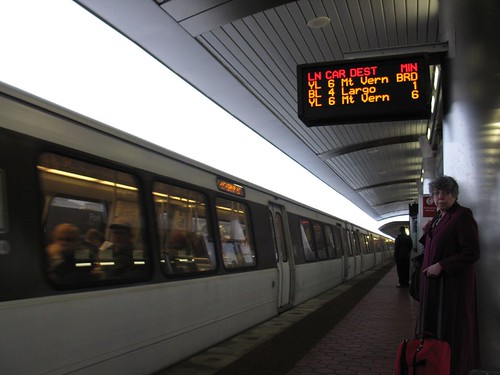For all its faults, the DC Metro tells riders how long they’ll have to wait. (Photo by flickr user NYCArthur)
Riders in Washington, D.C., know how long they have to wait for the next train. Straphangers in London are told how far away the next Underground subways are. Even Rome, with its graffiti-covered, two-line subway system, has managed to figure out train arrival boards. But not New York.
For years, New York City Transit has announced plans to bring this not-so-nascent technology into the subway system. In fact, they’ve been running a pilot program on the L line for years, and originally, this technology was to be ready for a system-wide roll-out in 2006. After announcing a projected 2009 launch date last December, the MTA has now admitted that the project is five years behind schedule and will not be ready until 2011 at the earliest.
Pete Donohue broke the story:
A project to display real-time train arrival times in 152 subway stations is now behind schedule – by five years. The project, featuring electronic message boards posted above subway platforms, was originally expected to be completed in 2006.
NYC Transit has pushed back that date several times over the years, citing software development problems, technical glitches and other problems. Earlier this week, officials pushed the date back again, this time to 2011. The delays in the $185 million project have frustrated riders and advocates who have seen such information provided in other cities around the world but not here.
“What a drag!” said Gene Russianoff of the Straphangers Campaign. “Riders really want to know when trains are due to arrive and when they are delayed.”
Besides the utter obviousness of Gene Russianoff’s quote, this project has turned into one giant joke. The MTA, for reasons both within their control and without it, have been unable to get a technological project off the ground, and now they’re talking about delaying it for five years. If I delivered something at work five years later, I would be fired.
Right now, we need this system simply to enjoy a modern subway system. But considering the price tag — $185 million — the delay and the fact that we’ve lived without it for so long, I have to wonder if this money wouldn’t be better spent elsewhere at this point. We all know the system could use it.


 With
With  In a ceremony this morning at Grand Central Terminal, Google and the MTA announced a partnership designed to bring New York Metropolitan area transit directions to Google Transit, a feature of the popular Google Maps. Users will now be able to find comprehensive directions for New York City Transit, the Long Island Rail Road, Metro-North and the area’s bus service in one place.
In a ceremony this morning at Grand Central Terminal, Google and the MTA announced a partnership designed to bring New York Metropolitan area transit directions to Google Transit, a feature of the popular Google Maps. Users will now be able to find comprehensive directions for New York City Transit, the Long Island Rail Road, Metro-North and the area’s bus service in one place. Facing a budget deficit of nearly $1 billion and with no relief in sight, the MTA is preparing an agency-wide cut of 4.5 percent. While officials say they will cut management costs first, if enough money can’t be trimmed, the agencies will be forced to cut operations costs, which, in plain English, means subway, bus and rail service could face the axe.
Facing a budget deficit of nearly $1 billion and with no relief in sight, the MTA is preparing an agency-wide cut of 4.5 percent. While officials say they will cut management costs first, if enough money can’t be trimmed, the agencies will be forced to cut operations costs, which, in plain English, means subway, bus and rail service could face the axe.  Despite facing a fare share of criticism over and some mixed results from its line manager program, the MTA is set to expand their program after a 10-month experiment.
Despite facing a fare share of criticism over and some mixed results from its line manager program, the MTA is set to expand their program after a 10-month experiment.
















